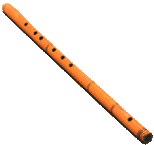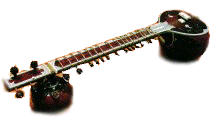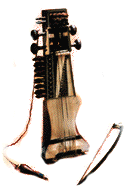









Stomp
Type of lively, rhythmic jazz music marked by a heavy beat. The term was probably derived from the early, foot-stomping forms of blues and ragtime dance music. "Stomp" was a common word to titles of music during the 1920s and 1930s. Besides having a "heavy" beat the rhythms of stomps are sharply defined, energetic and music associated with the stomp builds to a definitive climax.
Bikutsi
Bikutsi is a rhythmic style which originated with the Beti people of present day Cameroon. Literally it means to "thump the earth" which gives a strong indication that the Beti are what anthropologists would call "dirt affirming people"; that is, they recognize many aspects of human nature including those that are sexually driven. In origins the bikutsi rhythms were war and blood affirming. The music would call the people together by resounding through the forest. Such calls were made for requisite vengeance against other groups. These heavily energetic rhythms were meant to enjoin one's blood to boil -- in the figurative sense -- for the cause of war. Rhythmic dances of the bikutsi were preserved by the women as a response to Christian missionaries who attempted to "save" the people from their own "sinful" expressions. Story telling occurred followed by dances in which the shaking of the shoulders, back and buttocks were followed by a series of clapping.
SITAR
The sitar has two sound bodies and movable frets. Under the bridges there are twenty resonating strings that give the instrument its typical nasal sound, which is full of overtones. Because the main strings run only on the left part of the fret, they can be pulled to the right side allowing one to glide through the finest subtleties in pitch within an interval of up to three full notes. The sitar is considered the quintessential Indian instrument.
The Hexatones
..serve
to harmonise one's own being with one's personal situation and the best way
to go toward one's goal, thanks to the particular influence of the musical
fields placed according to the system of the 64 Hexagrams of the I-CHING.
Music, representation of the rhythms of the universe, meeting point between
time and space, foresees the laws of time. The musical incarnation of the
64 Hexagrams of the I-CHING has become possible thanks to Christian SAPHIR's
discovery of the principal of polar disposition of sounds in the twelve tones
of the scale. The result of the movement and change of the positions of the
"positive" tones and the "negative" tones allows the formation of particular
musical fields, each containing six tones. The identity of these new multi-symetrical
structures of the Hexagram system of the I-CHING is confirmed by the analysis
of chains or linking sequences of the harmonic ways, by the musical intervals,
and also by mathematics operations.
SARANGI
The sarangi is the most important string instrument in Gandharva Veda. The sarangi has three to four melody strings and thirteen to thirty-six resonating strings, and is played with a bow. The playing technique is very unusual because it is not touched with the fingertips the side and underside of the string is touched by the part of finger where fingernail begins to grow. Its full and very pleasing sound is highly esteemed when accompanying vocals. The echo effect from the resonating strings is stronger than that of the sitar or sarod
BANSURI (BAMBOO FLUTE)
Considered to be the original musical instrument, the bamboo flute is noted for being closest to the human singing voice. The richness from the fine nuances of pitch is accomplished by a subtle blowing technique and by partially covering the seven to eight finger holes. Each flute can only play in one scale.
SANTOOR
The santoor is called the 'shata tantra veena' the hundred-stringed lute. It produces a variety of lively tonal effects reminiscent of the piano or harp. The santoor is played with a pair of curved sticks made of walnut wood, and consists of a trapezoid-shaped sound body with twenty-five to twenty-nine bridges on each side and four strings per bridge. Two strings are tuned to the same pitch.
TABLA
The tabla consists of two single drums which are always played as a pair: the smaller wooden daya is played by the right hand, and the metallic kettle-drum-like baya is played by the left hand. The basic metre is kept on the baya, while variations are beaten on the daya.
